2017 FORD F150 seats
[x] Cancel search: seatsPage 4 of 599

Introduction
About This Manual...........................................7
Symbols Glossary
.............................................7
Data Recording
..................................................9
California Proposition 65..............................11
Perchlorate.........................................................11
Ford Credit
..........................................................11
Replacement Parts Recommendation.......................................12
Special Notices................................................12
Mobile Communications Equipment.....................................................13
Export Unique Options
.................................14
Environment
Protecting the Environment........................15
Child Safety
General Information
.......................................16
Installing Child Restraints
.............................17
Booster Seats..................................................29
Child Restraint Positioning
..........................31
Child Safety Locks..........................................32
Seatbelts
Principle of Operation..................................34
Fastening the Seatbelts...............................35
Seatbelt Height Adjustment......................39
Seatbelt Warning Lamp and Indicator Chime.............................................................39
Seatbelt Reminder
........................................40
Child Restraint and Seatbelt Maintenance................................................42
Seatbelt Extension
........................................42
Personal Safety System ™
Personal Safety System ™
..........................44Supplementary Restraints
System
Principle of Operation..................................45
Driver and Passenger Airbags...................46
Front Passenger Sensing System
............47
Side Airbags
.....................................................49
Safety Canopy ™
............................................50
Crash Sensors and Airbag Indicator.........51
Airbag Disposal
...............................................52
Keys and Remote Controls
General Information on Radio Frequencies..................................................53
Remote Control..............................................53
Replacing a Lost Key or Remote Control...........................................................58
MyKey ™
Principle of Operation
..................................59
Creating a MyKey...........................................60
Clearing All MyKeys
......................................60
Checking MyKey System Status
................61
Using MyKey With Remote Start Systems.........................................................62
MyKey Troubleshooting
...............................62
Doors and Locks
Locking and Unlocking
................................64
Keyless Entry...................................................66
Tailgate
Tailgate Lock....................................................69
Manual Tailgate..............................................69
Electronic Tailgate
.........................................69
Removing the Tailgate
.................................70
Tailgate Step
.....................................................71
Bed Extender
....................................................72
Security
Passive Anti-Theft System.........................74
1
F-150 (TFC) Canada/United States of America, enUSA, First Printing Table of Contents
Page 5 of 599
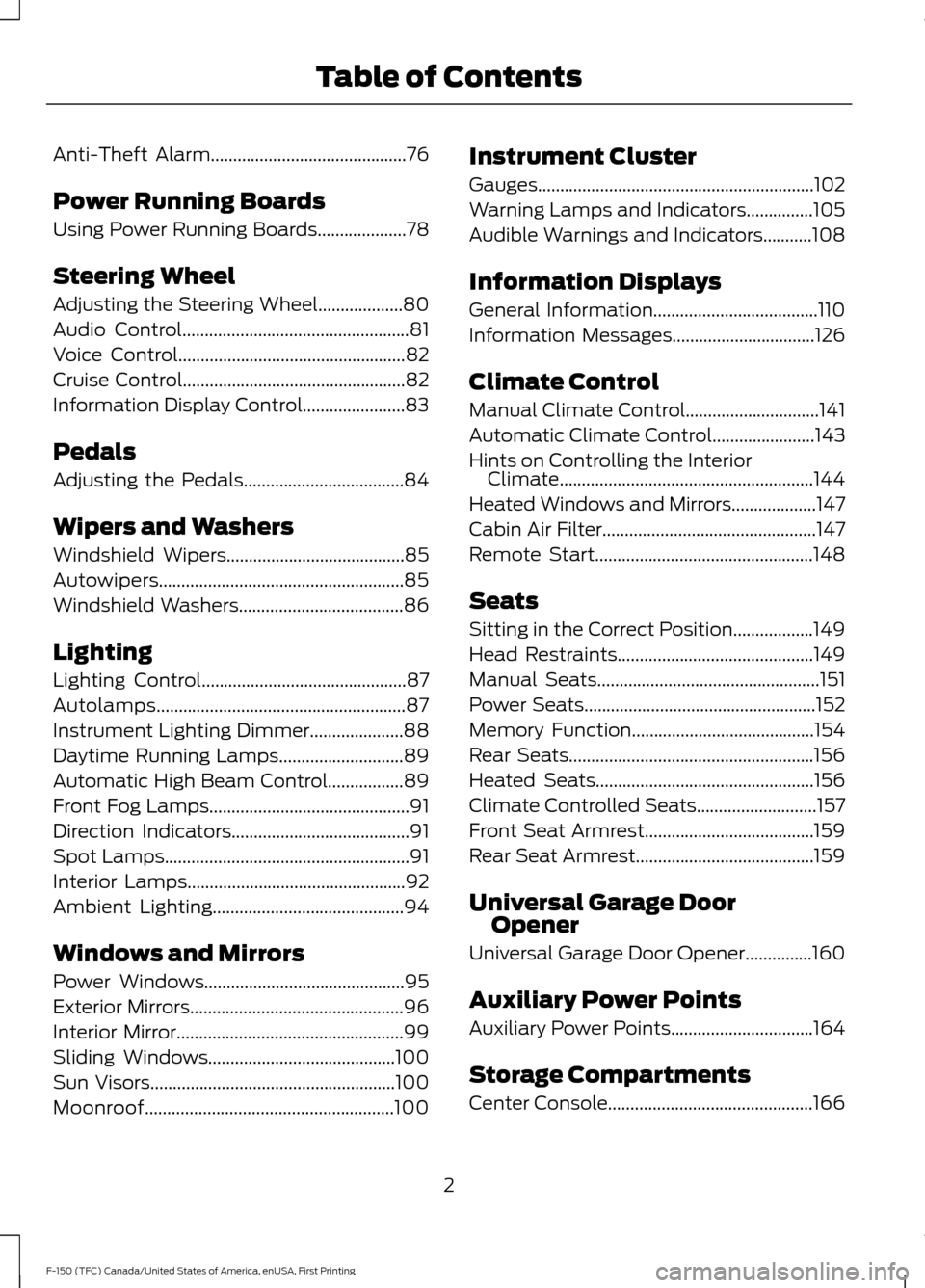
Anti-Theft Alarm............................................76
Power Running Boards
Using Power Running Boards....................78
Steering Wheel
Adjusting the Steering Wheel...................80
Audio Control
...................................................81
Voice Control
...................................................82
Cruise Control..................................................82
Information Display Control
.......................83
Pedals
Adjusting the Pedals....................................84
Wipers and Washers
Windshield Wipers........................................85
Autowipers.......................................................85
Windshield Washers.....................................86
Lighting
Lighting Control
..............................................87
Autolamps........................................................87
Instrument Lighting Dimmer.....................88
Daytime Running Lamps
............................89
Automatic High Beam Control.................89
Front Fog Lamps.............................................91
Direction Indicators
........................................91
Spot Lamps
.......................................................91
Interior Lamps
.................................................92
Ambient Lighting
...........................................94
Windows and Mirrors
Power Windows
.............................................95
Exterior Mirrors
................................................96
Interior Mirror
...................................................99
Sliding Windows..........................................100
Sun Visors
.......................................................100
Moonroof........................................................100 Instrument Cluster
Gauges
..............................................................
102
Warning Lamps and Indicators...............105
Audible Warnings and Indicators...........108
Information Displays
General Information.....................................110
Information Messages
................................126
Climate Control
Manual Climate Control..............................141
Automatic Climate Control
.......................143
Hints on Controlling the Interior Climate.........................................................144
Heated Windows and Mirrors
...................147
Cabin Air Filter
................................................147
Remote Start.................................................148
Seats
Sitting in the Correct Position..................149
Head Restraints
............................................149
Manual Seats
..................................................151
Power Seats
....................................................152
Memory Function
.........................................154
Rear Seats.......................................................156
Heated Seats
.................................................156
Climate Controlled Seats...........................157
Front Seat Armrest......................................159
Rear Seat Armrest........................................159
Universal Garage Door Opener
Universal Garage Door Opener...............160
Auxiliary Power Points
Auxiliary Power Points................................164
Storage Compartments
Center Console
..............................................166
2
F-150 (TFC) Canada/United States of America, enUSA, First Printing Table of Contents
Page 8 of 599

Cleaning Products......................................340
Cleaning the Exterior...................................341
Waxing.............................................................342
Cleaning the Engine....................................342
Cleaning the Windows and Wiper Blades..........................................................343
Cleaning the Interior...................................343
Cleaning the Instrument Panel and Instrument Cluster Lens.......................344
Cleaning Leather Seats.............................344
Repairing Minor Paint Damage
..............345
Cleaning the Wheels
..................................346
Vehicle Storage
............................................346
Wheels and Tires
General Information...................................349
Tire Care
...........................................................351
Using Snow Chains.....................................366
Tire Pressure Monitoring System
...........367
Changing a Road Wheel............................372
Technical Specifications
..........................380
Capacities and Specific- ations
Engine Specifications - 2.7L EcoBoost™.................................................381
Engine Specifications - 3.5L.....................381
Engine Specifications - 3.5L Ecoboost™................................................382
Engine Specifications - 5.0L...................383
Motorcraft Parts - 2.7L EcoBoost™
......383
Motorcraft Parts - 3.5L..............................384
Motorcraft Parts - 3.5L Ecoboost™......385
Motorcraft Parts - 5.0L
.............................385
Vehicle Identification Number
...............386
Vehicle Certification Label.......................387
Transmission Code Designation............387
Capacities and Specifications - 2.7L EcoBoost™...............................................388
Capacities and Specifications - 3.5L....392 Capacities and Specifications - 3.5L
Ecoboost™................................................396
Capacities and Specifications - 5.0L..............................................................400
Audio System
General Information...................................405
Audio Unit - Vehicles With: AM/FM......406
Audio Unit - Vehicles With: AM/FM/ CD.................................................................408
Audio Unit - Vehicles With: AM/FM/ SYNC..............................................................411
Audio Unit - Vehicles With: AM/FM/CD/ SYNC/Satellite Radio
.............................413
Audio Unit - Vehicles With: Sony AM/FM/ CD...................................................................415
Digital Radio
...................................................417
Satellite Radio
...............................................419
USB Port
..........................................................422
Media Hub
......................................................422
SYNC™
General Information
...................................423
Using Voice Recognition...........................425
Using SYNC™ With Your Phone
............427
SYNC™ Applications and Services......439
Using SYNC™ With Your Media Player...........................................................444
SYNC™ Troubleshooting.........................453
SYNC™ 3
General Information
....................................461
Home Screen
.................................................472
Using Voice Recognition............................473
Entertainment..............................................480
Climate...........................................................490
Phone...............................................................492
Navigation......................................................498
Apps
.................................................................506
Settings...........................................................509
SYNC™ 3 Troubleshooting.......................521
5
F-150 (TFC) Canada/United States of America, enUSA, First Printing Table of Contents
Page 15 of 599
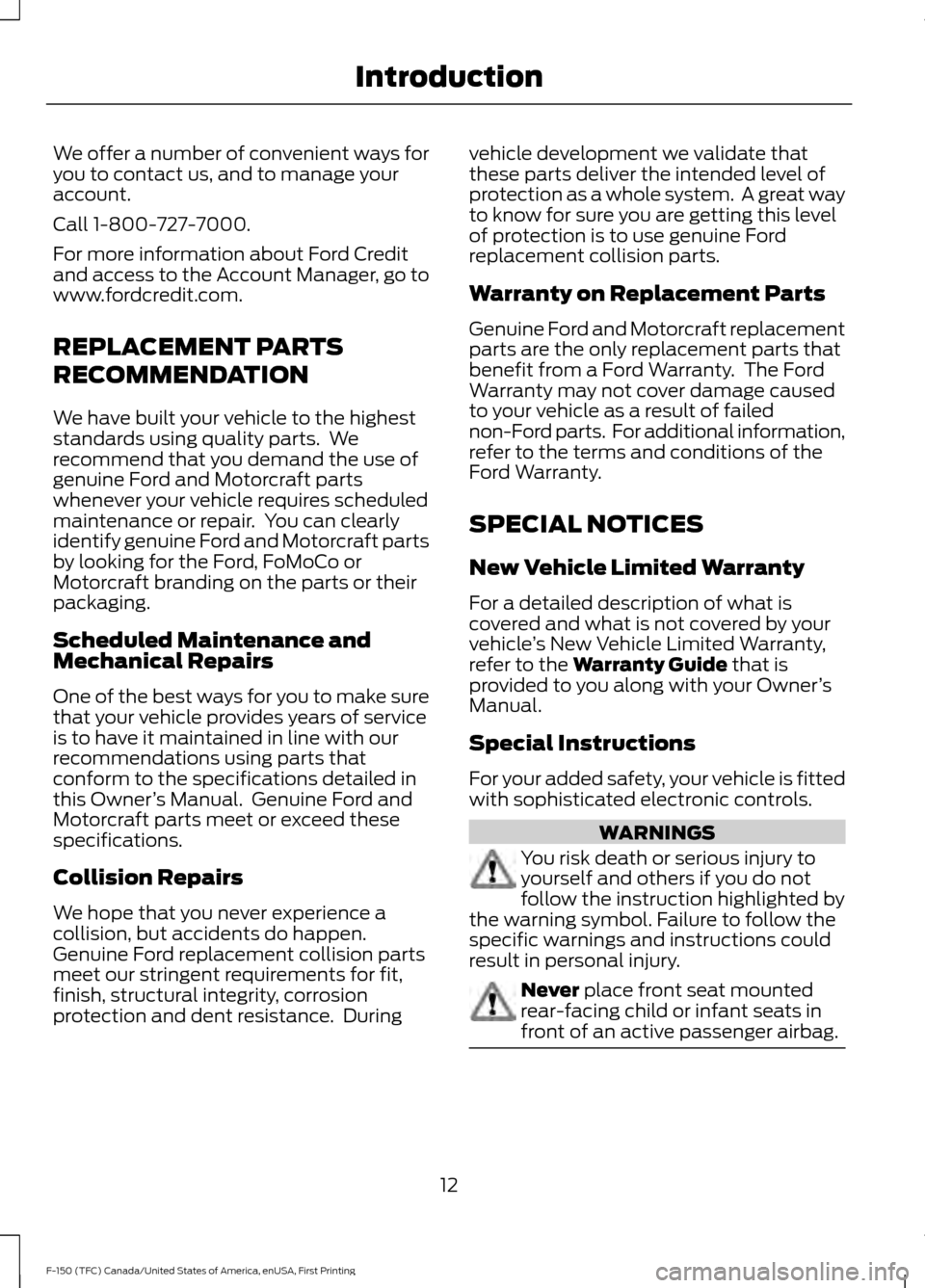
We offer a number of convenient ways for
you to contact us, and to manage your
account.
Call 1-800-727-7000.
For more information about Ford Credit
and access to the Account Manager, go to
www.fordcredit.com.
REPLACEMENT PARTS
RECOMMENDATION
We have built your vehicle to the highest
standards using quality parts. We
recommend that you demand the use of
genuine Ford and Motorcraft parts
whenever your vehicle requires scheduled
maintenance or repair. You can clearly
identify genuine Ford and Motorcraft parts
by looking for the Ford, FoMoCo or
Motorcraft branding on the parts or their
packaging.
Scheduled Maintenance and
Mechanical Repairs
One of the best ways for you to make sure
that your vehicle provides years of service
is to have it maintained in line with our
recommendations using parts that
conform to the specifications detailed in
this Owner
’s Manual. Genuine Ford and
Motorcraft parts meet or exceed these
specifications.
Collision Repairs
We hope that you never experience a
collision, but accidents do happen.
Genuine Ford replacement collision parts
meet our stringent requirements for fit,
finish, structural integrity, corrosion
protection and dent resistance. During vehicle development we validate that
these parts deliver the intended level of
protection as a whole system. A great way
to know for sure you are getting this level
of protection is to use genuine Ford
replacement collision parts.
Warranty on Replacement Parts
Genuine Ford and Motorcraft replacement
parts are the only replacement parts that
benefit from a Ford Warranty. The Ford
Warranty may not cover damage caused
to your vehicle as a result of failed
non-Ford parts. For additional information,
refer to the terms and conditions of the
Ford Warranty.
SPECIAL NOTICES
New Vehicle Limited Warranty
For a detailed description of what is
covered and what is not covered by your
vehicle
’s New Vehicle Limited Warranty,
refer to the Warranty Guide that is
provided to you along with your Owner ’s
Manual.
Special Instructions
For your added safety, your vehicle is fitted
with sophisticated electronic controls. WARNINGS
You risk death or serious injury to
yourself and others if you do not
follow the instruction highlighted by
the warning symbol. Failure to follow the
specific warnings and instructions could
result in personal injury. Never
place front seat mounted
rear-facing child or infant seats in
front of an active passenger airbag. 12
F-150 (TFC) Canada/United States of America, enUSA, First Printing Introduction
Page 20 of 599
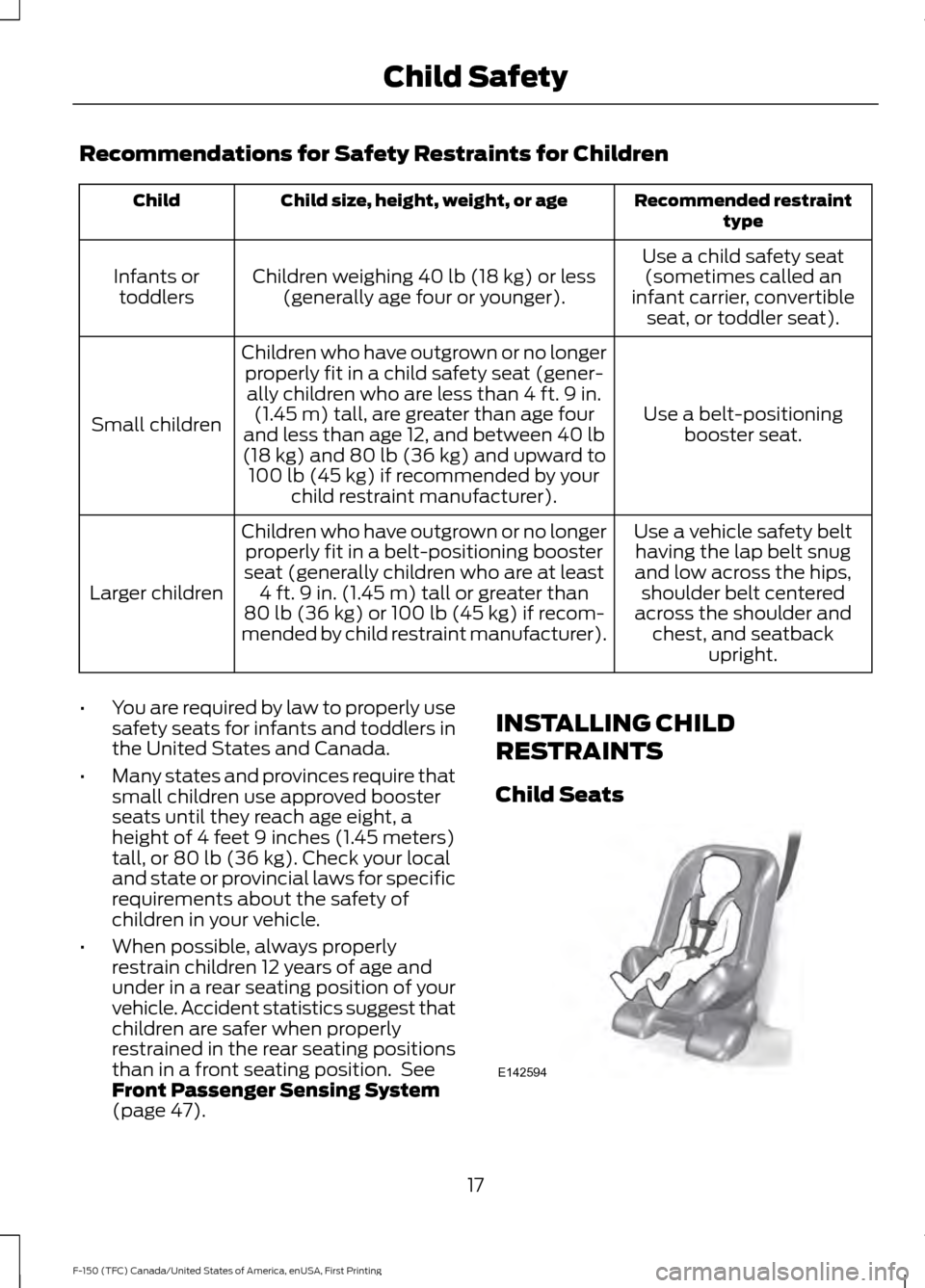
Recommendations for Safety Restraints for Children
Recommended restraint
type
Child size, height, weight, or age
Child
Use a child safety seat(sometimes called an
infant carrier, convertible seat, or toddler seat).
Children weighing 40 lb (18 kg) or less
(generally age four or younger).
Infants or
toddlers
Use a belt-positioningbooster seat.
Children who have outgrown or no longer
properly fit in a child safety seat (gener-ally children who are less than 4 ft. 9 in. (1.45 m) tall, are greater than age four
and less than age 12, and between
40 lb
(18 kg) and 80 lb (36 kg) and upward to
100 lb (45 kg) if recommended by your
child restraint manufacturer).
Small children
Use a vehicle safety belthaving the lap belt snug
and low across the hips, shoulder belt centered
across the shoulder and chest, and seatback upright.
Children who have outgrown or no longer
properly fit in a belt-positioning booster
seat (generally children who are at least 4 ft. 9 in. (1.45 m) tall or greater than
80 lb (36 kg)
or 100 lb (45 kg) if recom-
mended by child restraint manufacturer).
Larger children
• You are required by law to properly use
safety seats for infants and toddlers in
the United States and Canada.
• Many states and provinces require that
small children use approved booster
seats until they reach age eight, a
height of 4 feet 9 inches (1.45 meters)
tall, or
80 lb (36 kg). Check your local
and state or provincial laws for specific
requirements about the safety of
children in your vehicle.
• When possible, always properly
restrain children 12 years of age and
under in a rear seating position of your
vehicle. Accident statistics suggest that
children are safer when properly
restrained in the rear seating positions
than in a front seating position. See
Front Passenger Sensing System
(page
47). INSTALLING CHILD
RESTRAINTS
Child Seats
17
F-150 (TFC) Canada/United States of America, enUSA, First Printing Child SafetyE142594
Page 22 of 599
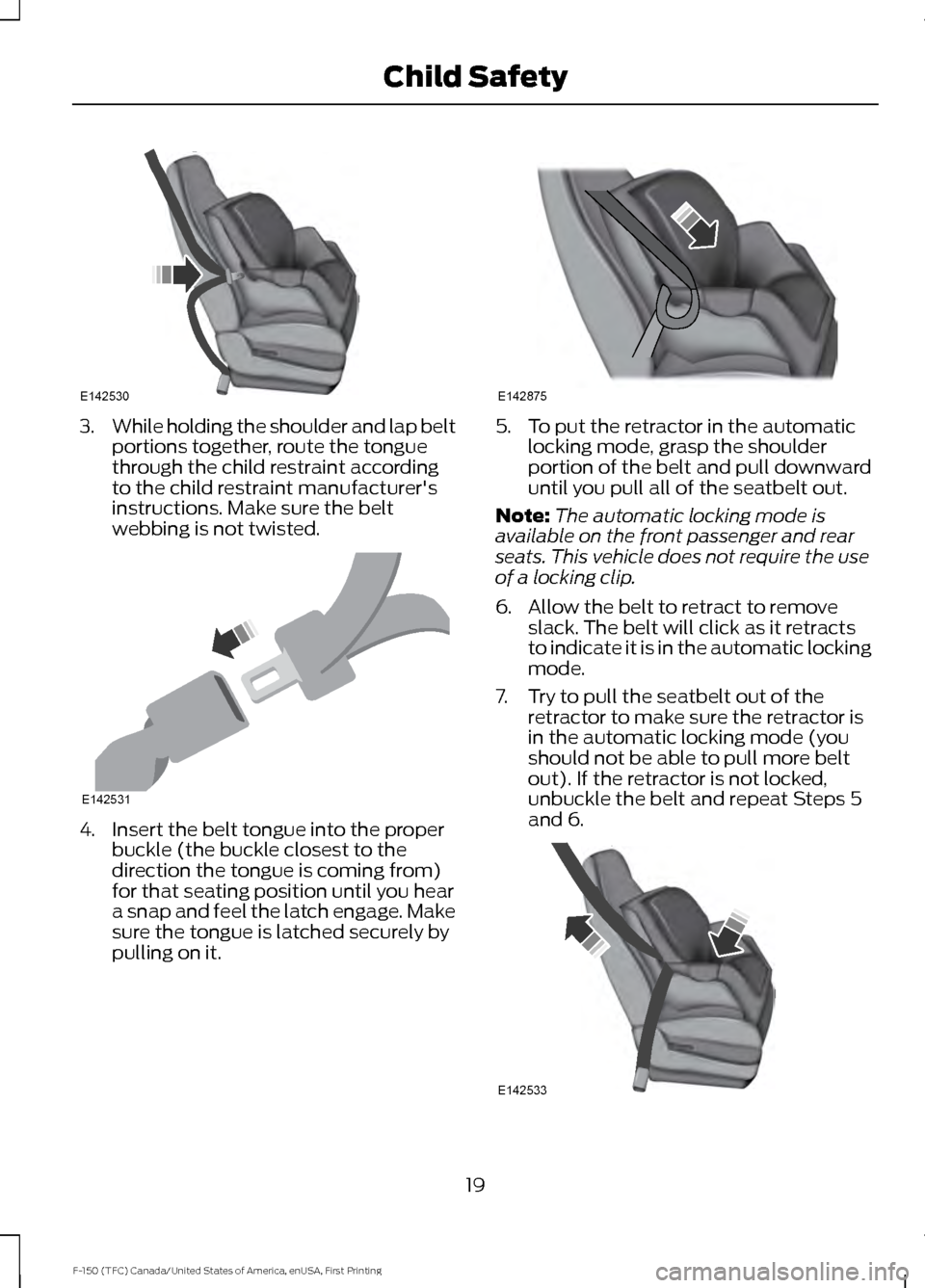
3.
While holding the shoulder and lap belt
portions together, route the tongue
through the child restraint according
to the child restraint manufacturer's
instructions. Make sure the belt
webbing is not twisted. 4. Insert the belt tongue into the proper
buckle (the buckle closest to the
direction the tongue is coming from)
for that seating position until you hear
a snap and feel the latch engage. Make
sure the tongue is latched securely by
pulling on it. 5. To put the retractor in the automatic
locking mode, grasp the shoulder
portion of the belt and pull downward
until you pull all of the seatbelt out.
Note: The automatic locking mode is
available on the front passenger and rear
seats. This vehicle does not require the use
of a locking clip.
6. Allow the belt to retract to remove slack. The belt will click as it retracts
to indicate it is in the automatic locking
mode.
7. Try to pull the seatbelt out of the retractor to make sure the retractor is
in the automatic locking mode (you
should not be able to pull more belt
out). If the retractor is not locked,
unbuckle the belt and repeat Steps 5
and 6. 19
F-150 (TFC) Canada/United States of America, enUSA, First Printing Child SafetyE142530 E142531 E142875 E142533
Page 26 of 599
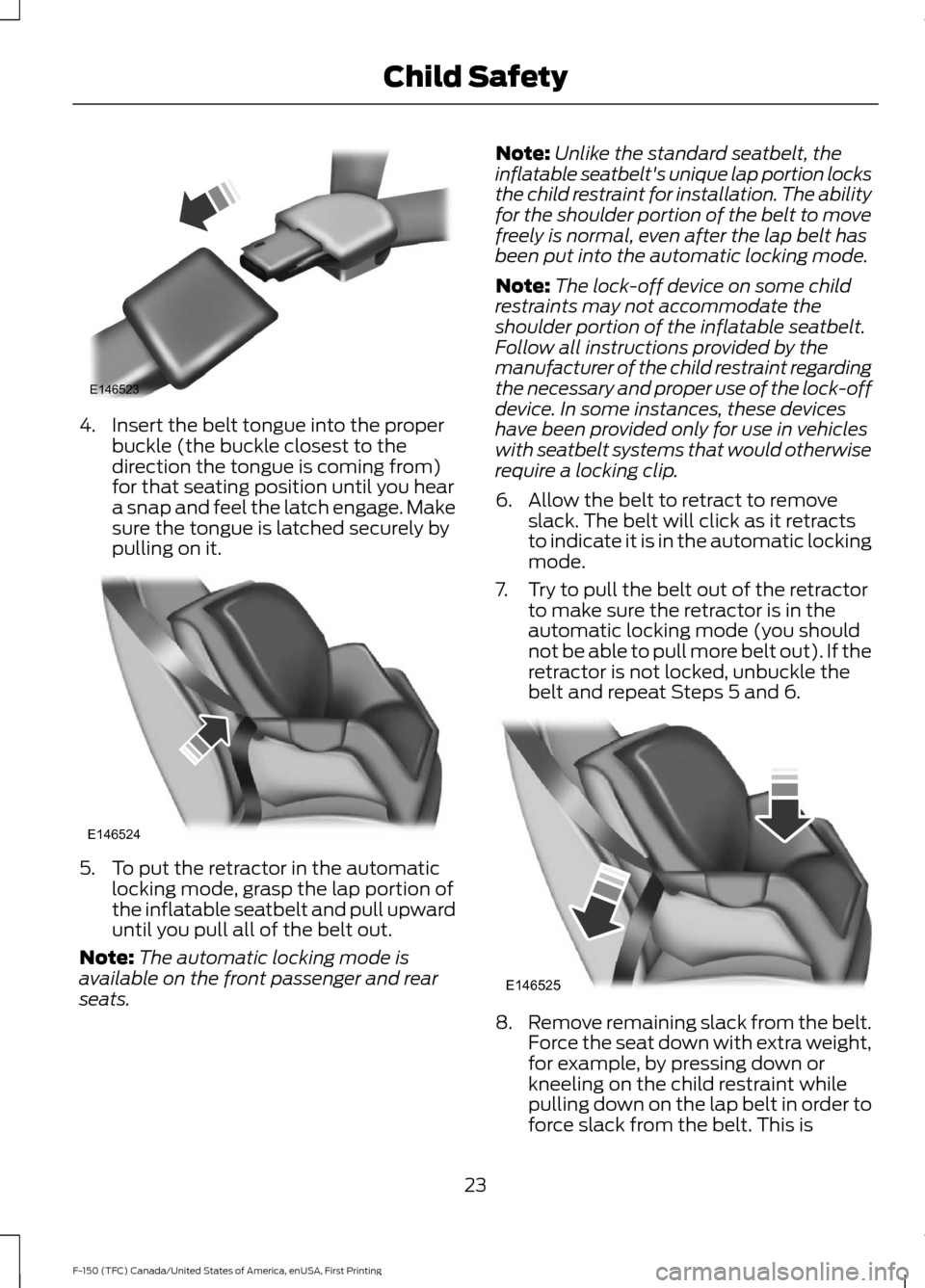
4. Insert the belt tongue into the proper
buckle (the buckle closest to the
direction the tongue is coming from)
for that seating position until you hear
a snap and feel the latch engage. Make
sure the tongue is latched securely by
pulling on it. 5. To put the retractor in the automatic
locking mode, grasp the lap portion of
the inflatable seatbelt and pull upward
until you pull all of the belt out.
Note: The automatic locking mode is
available on the front passenger and rear
seats. Note:
Unlike the standard seatbelt, the
inflatable seatbelt's unique lap portion locks
the child restraint for installation. The ability
for the shoulder portion of the belt to move
freely is normal, even after the lap belt has
been put into the automatic locking mode.
Note: The lock-off device on some child
restraints may not accommodate the
shoulder portion of the inflatable seatbelt.
Follow all instructions provided by the
manufacturer of the child restraint regarding
the necessary and proper use of the lock-off
device. In some instances, these devices
have been provided only for use in vehicles
with seatbelt systems that would otherwise
require a locking clip.
6. Allow the belt to retract to remove slack. The belt will click as it retracts
to indicate it is in the automatic locking
mode.
7. Try to pull the belt out of the retractor to make sure the retractor is in the
automatic locking mode (you should
not be able to pull more belt out). If the
retractor is not locked, unbuckle the
belt and repeat Steps 5 and 6. 8.
Remove remaining slack from the belt.
Force the seat down with extra weight,
for example, by pressing down or
kneeling on the child restraint while
pulling down on the lap belt in order to
force slack from the belt. This is
23
F-150 (TFC) Canada/United States of America, enUSA, First Printing Child SafetyE146523 E146524 E146525
Page 27 of 599
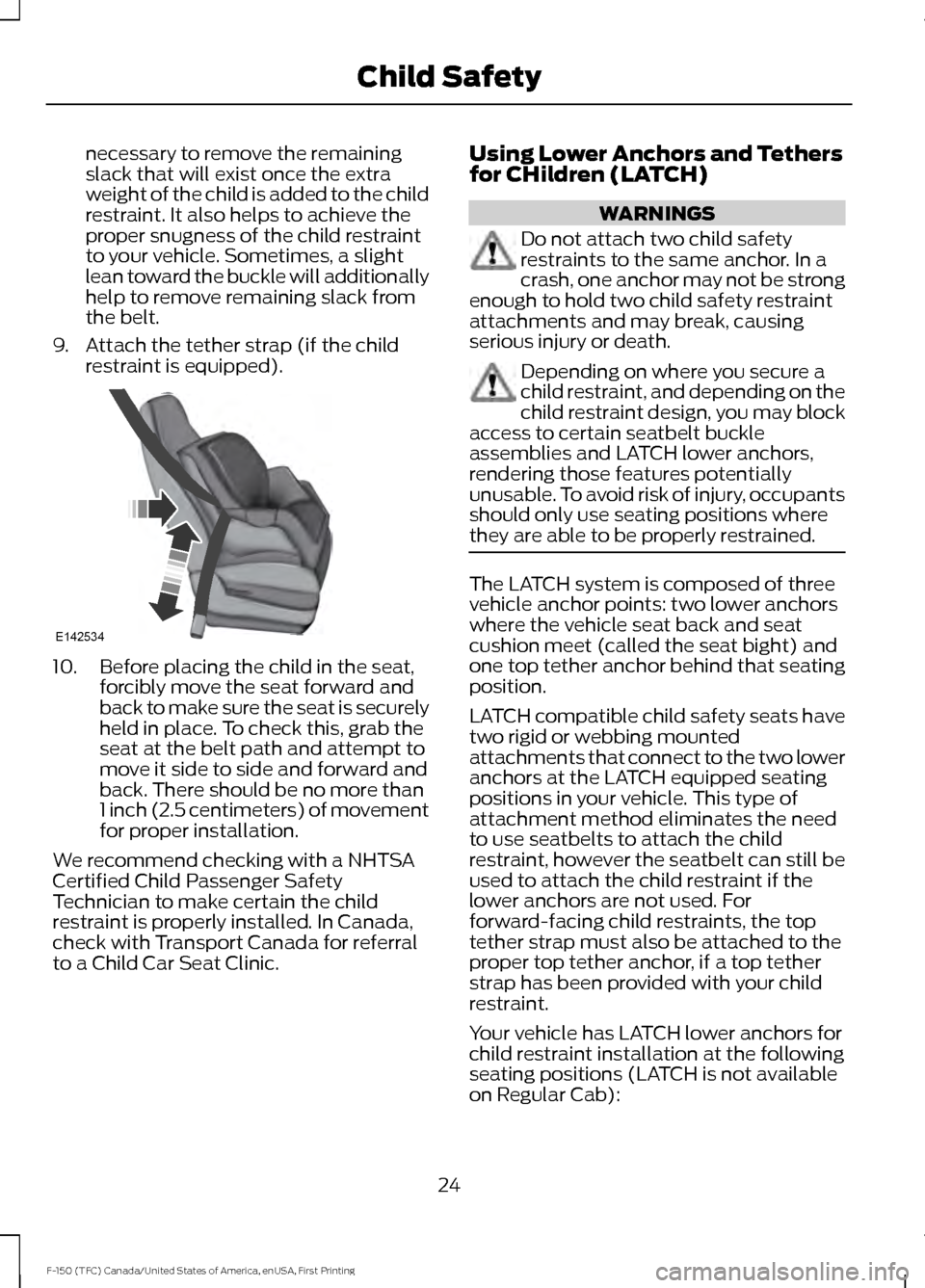
necessary to remove the remaining
slack that will exist once the extra
weight of the child is added to the child
restraint. It also helps to achieve the
proper snugness of the child restraint
to your vehicle. Sometimes, a slight
lean toward the buckle will additionally
help to remove remaining slack from
the belt.
9. Attach the tether strap (if the child restraint is equipped). 10. Before placing the child in the seat,
forcibly move the seat forward and
back to make sure the seat is securely
held in place. To check this, grab the
seat at the belt path and attempt to
move it side to side and forward and
back. There should be no more than
1 inch (2.5 centimeters) of movement
for proper installation.
We recommend checking with a NHTSA
Certified Child Passenger Safety
Technician to make certain the child
restraint is properly installed. In Canada,
check with Transport Canada for referral
to a Child Car Seat Clinic. Using Lower Anchors and Tethers
for CHildren (LATCH) WARNINGS
Do not attach two child safety
restraints to the same anchor. In a
crash, one anchor may not be strong
enough to hold two child safety restraint
attachments and may break, causing
serious injury or death. Depending on where you secure a
child restraint, and depending on the
child restraint design, you may block
access to certain seatbelt buckle
assemblies and LATCH lower anchors,
rendering those features potentially
unusable. To avoid risk of injury, occupants
should only use seating positions where
they are able to be properly restrained. The LATCH system is composed of three
vehicle anchor points: two lower anchors
where the vehicle seat back and seat
cushion meet (called the seat bight) and
one top tether anchor behind that seating
position.
LATCH compatible child safety seats have
two rigid or webbing mounted
attachments that connect to the two lower
anchors at the LATCH equipped seating
positions in your vehicle. This type of
attachment method eliminates the need
to use seatbelts to attach the child
restraint, however the seatbelt can still be
used to attach the child restraint if the
lower anchors are not used. For
forward-facing child restraints, the top
tether strap must also be attached to the
proper top tether anchor, if a top tether
strap has been provided with your child
restraint.
Your vehicle has LATCH lower anchors for
child restraint installation at the following
seating positions (LATCH is not available
on Regular Cab):
24
F-150 (TFC) Canada/United States of America, enUSA, First Printing Child SafetyE142534